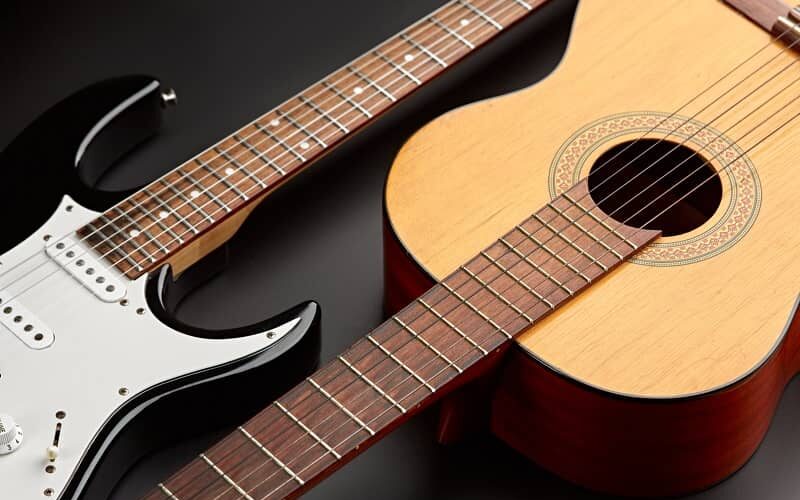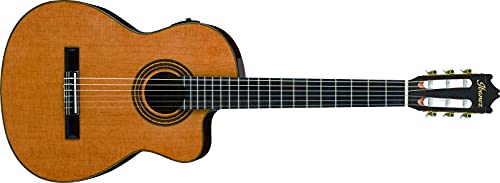If you’re considering buying a guitar or are just learning to play, you’ve probably heard or read lessons, reviews, or tutorials referring to a guitar’s frets.
Without understanding what a guitar’s frets are and what purposes they serve, you likely won’t be able to progress very far on the instrument; the good news is, it’s not the least bit complicated.
Whether you have some notion of what we’re talking about when we refer to a guitar’s frets or none at all, don’t worry. In the following article, we’ll cover what frets are, what function they perform, and how many frets different styles and varieties of guitars have.
What Is A Guitar Fret
The guitar is a fretted instrument, meaning the guitar neck is delineated by raised metal strips or thin bars of metal called frets. Frets on a guitar act as a guide for the player, letting them know exactly where to depress a string to sound a particular note.
It’s important to understand that “fret” refers to the metal bar on the guitar’s neck, not one of the resulting spaces between any two given bars.
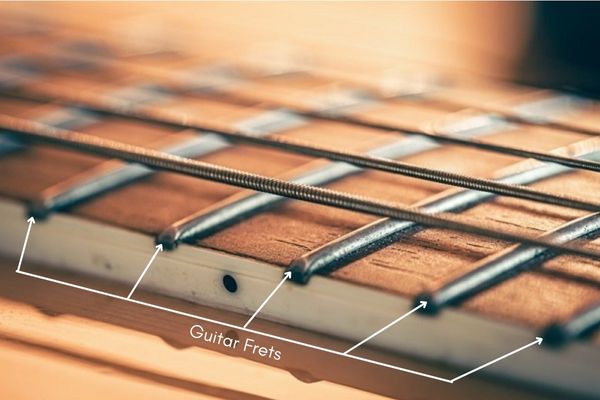
How Do Guitar Frets Work?
Generally speaking, frets on a guitar serve two purposes. First and most importantly, they designate where a string will sound a particular note when depressed at that position. For example, fingering a note on the fifth fret of the A string will sound the note D on a standard-tuned guitar.
Another function of the guitar fret is to designate where to finger a note for optimal sound. As a rule, notes sound best when played as closely as possible to the left side of the fret.
For example, for the best-sounding D note we mentioned above, finger the A string as close to the left side of the fifth fret as possible. If the note begins to sound muted, you’re fingering too close to the fret and will need to back off.
Not all stringed instruments have frets; violins, violas, and standing basses, for example, are all fretless stringed instruments. There are fretless guitars, but having longer necks and more strings than most fretless instruments, they require a far greater degree of precision to play.
Number Of Frets On An Electric Guitar
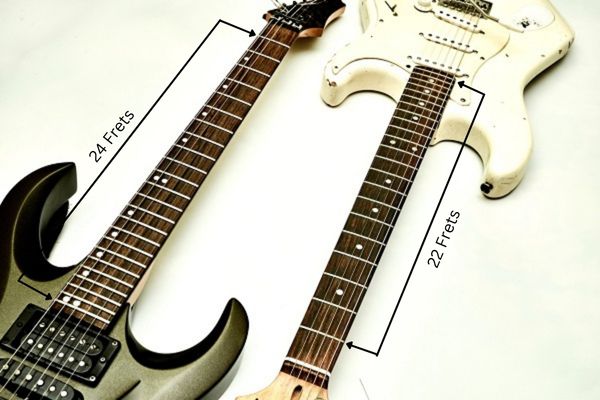
The number of frets a guitar has depends primarily on its year and model. Regarding electrics, most modern guitars have between twenty-one and twenty-four frets; short-scale and children’s electric guitars typically have fewer.
Let’s take a look at some of the most popular electric guitar models and the number of frets each has:
Fender Telecaster And Stratocaster
Two of the most popular electric guitars ever made, Fender’s Telecaster and Stratocaster models, are played by guitar luminaries like David Gilmour, Jeff Beck, and Eric Clapton. Most Telecasters and Stratocasters have twenty-two frets, though some classic-style and vintage models have twenty-one.
Two more of Fender’s most popular electric guitars, the Jazzmaster and Jaguar, also come with twenty-two frets.
Ibanez RG
One of Ibanez Guitar’s most popular models, the Ibanez RG is available in more subtypes than any other Ibanez offering. One of the things that makes this guitar so popular is its cutaway body style which allows for a full twenty-four frets.
Progressive, nu-metal, and fusion guitarists make good use of these extra frets, as do jazz players and neo-classicists.
Gibson/Epiphone Les Paul
The preferred ax of guitar legends Jimmy Page, Randy Rhoades, and, of course, the man Les himself, Gibson’s Les Paul is one of the most distinctive and recognizable electric guitars in the world. Most Gibson/Epiphone Les Pauls have twenty-two frets, with the neck joining the body at the sixteenth.
Number Of Frets On An Acoustic Guitar
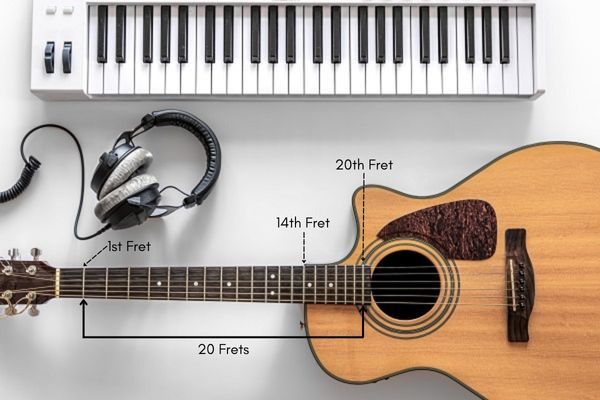
Standard acoustic guitars and steel-stringed acoustic guitars have fewer frets than electrics, usually between eighteen and twenty frets. On non-cutaway acoustic guitars like dreadnoughts, fret access is limited after the fourteenth fret, where the neck meets the guitar’s top.
How Many Frets Are On A Bass Guitar?
When it comes to guitars, it’s best not to talk in absolutes. Someone’s constantly innovating, coming up with new designs; as I write, someone may well be bolting a twenty-six fret neck to a guitar or bass in their home workshop.
Now, the necessary disclaimer out of the way, most bass guitars manufactured today have twenty-one, twenty-two, or twenty-four frets.
How Many Frets Do Classical And Flamenco Guitars Have?
Classical guitars differ from standard acoustic guitars in several significant ways, including the number of frets they have. Most classical guitars have only seventeen through nineteen frets, and their necks typically join the body at the twelfth fret.
Engineered initially to be heard over the percussive sounds of Flamenco dancing, Flamenco guitars differ from standard classical and acoustic guitars in that they are heavy on attack and light on sustain.
Like classical acoustics, Flamenco guitars most often have between seventeen and nineteen frets, and the neck joins the guitar body at or around the twelfth fret.
How Many Frets Does A 3/4 Scale Guitar Have?
Designed for children or adults who lack reach or hand strength, three-quarter scale guitars are an excellent alternative for the ultra-petite guitarist. How many frets a 3/4 scale guitar has will vary by brand and model, but the vast majority have twenty.
Guitar Fret Size
No discussion of guitar frets would be complete without a look at fret sizes. You may have read or heard of a guitar being described as having “Jumbo” frets; if you’re anything like me, you may well have jumped to the wrong conclusion about what, exactly, that means. When I first heard the term, I wrongly assumed it referred to the width of the spaces between the frets.
As mentioned earlier, a “fret” is one of the thin metal bars that run perpendicular to the strings on a guitar’s neck, not the spaces between those bars. As such, fret size has everything to do with the actual size of the metal bar.
To understand fret size, it helps to know that frets have two essential parts, a tang and a crown. The tang is the part of the fret hammered into the neck; you shouldn’t be able to see the tang once the frets have been affixed. The crown is the part of the fret that remains above the neck. When we talk about a fret’s size, what we actually mean is the size of its crown.
Five Most Common Fret Sizes:
By far the largest and most popular manufacturer of guitar fret wire, Dunlop Manufacturing, Inc. of California, produces five distinct sizes of guitar frets. They are listed below, from smallest to largest, with their part numbers:
PART 6230 is the smallest guitar fret wire available. Found on older Fenders and some other vintage guitars, these frets have crowns that measure .078″ x .043″ (width x height.)
PART 6105, commonly known as “modern narrow tall” frets, measure .090″ x .042″ and currently enjoy great popularity.
PART 6150 is wider than part 6230 but slightly lower in height. Measuring .102″ x .042″, these frets are known as “vintage jumbo.”
PART 6130, or “medium jumbo” frets, are very wide, but they’re also the lowest crowns of any frets produced by Dunlop.
PART 6100 is the largest fret wire manufactured by Dunlop. Known as “Jumbo” frets, this wire is significantly broader and taller than any other type. The crown of a jumbo fret measures .110 x .055″.
Few More Available Fret Sizes
Does Fret Size Affect Playing?
When choosing a guitar, it’s important to keep in mind that the size of the frets will, to a greater or lesser extent, affect how you play it. That said, playing guitars with different-sized frets usually requires only a small adjustment; once you’re used to playing on different types, switching between them becomes far more a matter of preference than necessity.
Why Does The Number Of Frets On A Guitar Matter?
You may be asking, does the number of frets a guitar has matter, and if so, how much? The answer to that question depends, to a great degree, on your skill level and guitar goals.
Usually, a beginner guitarist isn’t going to need more than twenty-one frets; one could argue that until students master the first twelve frets on a guitar (representing one octave per string), they shouldn’t be distracting themselves with frets higher than that.
It usually isn’t until a guitarist begins learning to solo that how many frets a guitar has and how accessible they become an issue. For example, my favorite guitar is a telecaster; I play everything on it, from the blues to heavy metal to folk.
It wasn’t until I’d progressed enough to start learning some of my favorite guitar solos that the number of frets on my Tele became an issue. I was able to play licks, but accessing some of the higher frets was challenging as the heel of my hand butted against my guitar’s body.
About the Author
Thomas M., the founder of Guitar Top Review, boasts 15+ years of guitar experience and was a church band member in L.A. Transitioning from piano to acoustic guitar, his first love remains his Taylor GS Mini. Alongside like-minded hobbyist friends, he launched the site, driven by a deep love for music that transcends professional boundaries.

